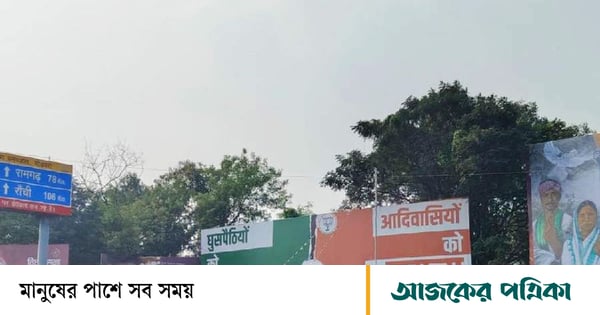BJP's huge banner-hoarding near almost every intersection in Jharkhand. In these two options are given before the voters. One read, 'Either shelter the intruders or save the natives.' Same message on other banner-hoardings. All this is basically a fear-mongering strategy about Bangladeshi infiltrators in the state.
The background colors of these banner-hoardings are ocher and green. which is related to the politics and religion of South Asia. More specifically, ocher is the color of BJP's Hindu nationalism and green is that of Muslims. This is the main campaign of BJP in the Jharkhand assembly elections. They claim, 'India' coalition is protecting Bangladeshi infiltrators. The BJP alleged that these intruders are conspiring against the tribals of Jharkhand.
The closest route from Jharkhand to Bangladesh is through Pakur district. This district is on the north-eastern border of the state. Between them are more than 9 km of arable land and the Ganges River, which falls in West Bengal. After that, the border of Chapainawabganj district of Bangladesh.
The Muslim population in Jharkhand is 14.53 percent, but the presence of this community in the state assembly is 5 percent of the seats. They are not majority in any district. However, their number is more in Pakur and Sahebganj districts in Santal Parganas. The Muslim population here is more than 34 percent.
Santal Pargana is the stronghold of Jharkhand's current ruling party Mukti Morcha (JMM). Most tribals, especially the Santals, support the JMM. However, they are wary of BJP's anti-Bangladeshi campaign.
Gomeshwar Saren, a candidate in the JMM base of Nala in Jamtara district, was busy rallying supporters in Palajori village. At that time, a BJP campaign vehicle passed the rally. A call to save 'Ruti, Mati, Beti (Food, Land, Girl)' written on the van.
When asked if this slogan influenced the voters, Gomeshwar said, 'There are some arguments with Muslims in the village, but we settle them ourselves. I don't know any Bangladeshi. The center guards the border. West Bengal borders Bangladesh. Let Mamata ask Didi, why us?'
Senior leaders interrupted the Communist Party of India (CPI) office in Nala while addressing a rally on communal tension among students in various educational institutions. Asked whether the BJP's inflammatory campaign was being discussed at the local Nala Degree College, Vidhan Mondal, a student at the college, told The Telegraph, “Some students think so.”
However, senior CPI leader Nimai Mahato stopped him and said, 'These are meaningless words! BJP is poisoning people's minds. The CPI has won the seat here nine times. People are intelligent. We demand jobs and better education.'
Former teacher Dilip Hembram said in the rally, 'The media is increasing this divisive politics. Adivasis, Hindus and Muslims lived together in peace. The unity has not yet been completely destroyed. We created Jharkhand for the welfare of tribals. Building unity is difficult but still we are united enough to stop BJP.'
Ramachandra Madhaiya of Kedue village appreciated the welfare work of Chief Minister Hemant Saren's government. He said, 'JMM will win here. But sometimes it seems that there may be truth in what the BJP is saying. If BJP was in power, Muslims would have been kept under control. Mamata has created this problem.' Asked if he has ever been in conflict with Muslims, he shakes his head and says, 'No, but they are a little rough.'
Barhait Chief Minister Hemant Saren own center of Pakur district. The BJP flag is rarely seen here. And the village of Bhognadihi is the center of the historical rebellion of Santal leader Sidhu-Kanu Murmud. Mandal Murmu, a descendant of the Sidhu-Kanur clan, initially sided with Hemant Saren. Later he joined BJP. He alleged that Bangladeshis have dominated Bhognadihi and fly only one party flag.
JMM flags abound at Talbaria Chowk. In this place, young people have night chats, fried eggs and sit in tea shops. Shopkeepers can speak Saotali, Bengali and Hindi with ease. Farid Ansari considers this matter as an expression of unity between Bengalis, Santals and tribal groups and Hindus. This Congress supporter said, 'Our unity has become stronger after Bharat Joro Nyaya Yatra.'

